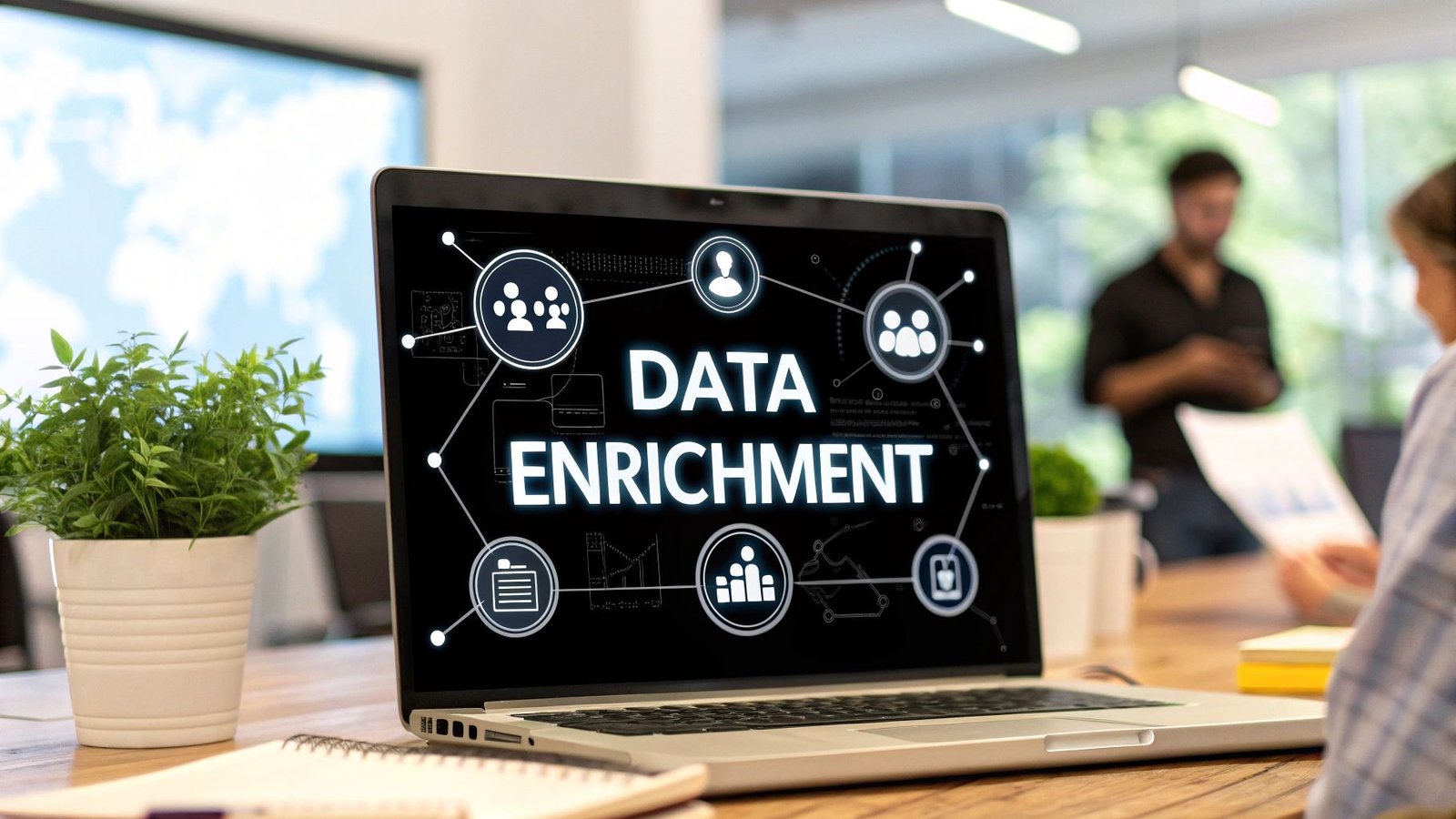So, what exactly is CRM data enrichment? Think of it as taking your existing customer information and layering on valuable, verified details from other sources. It's the process of turning a skeletal contact record into a full-bodied, actionable customer profile. This is absolutely essential because it fights off the inevitable decay of data and fills in the blanks your sales team needs to actually connect and sell.
Why Your CRM Needs Data Enrichment
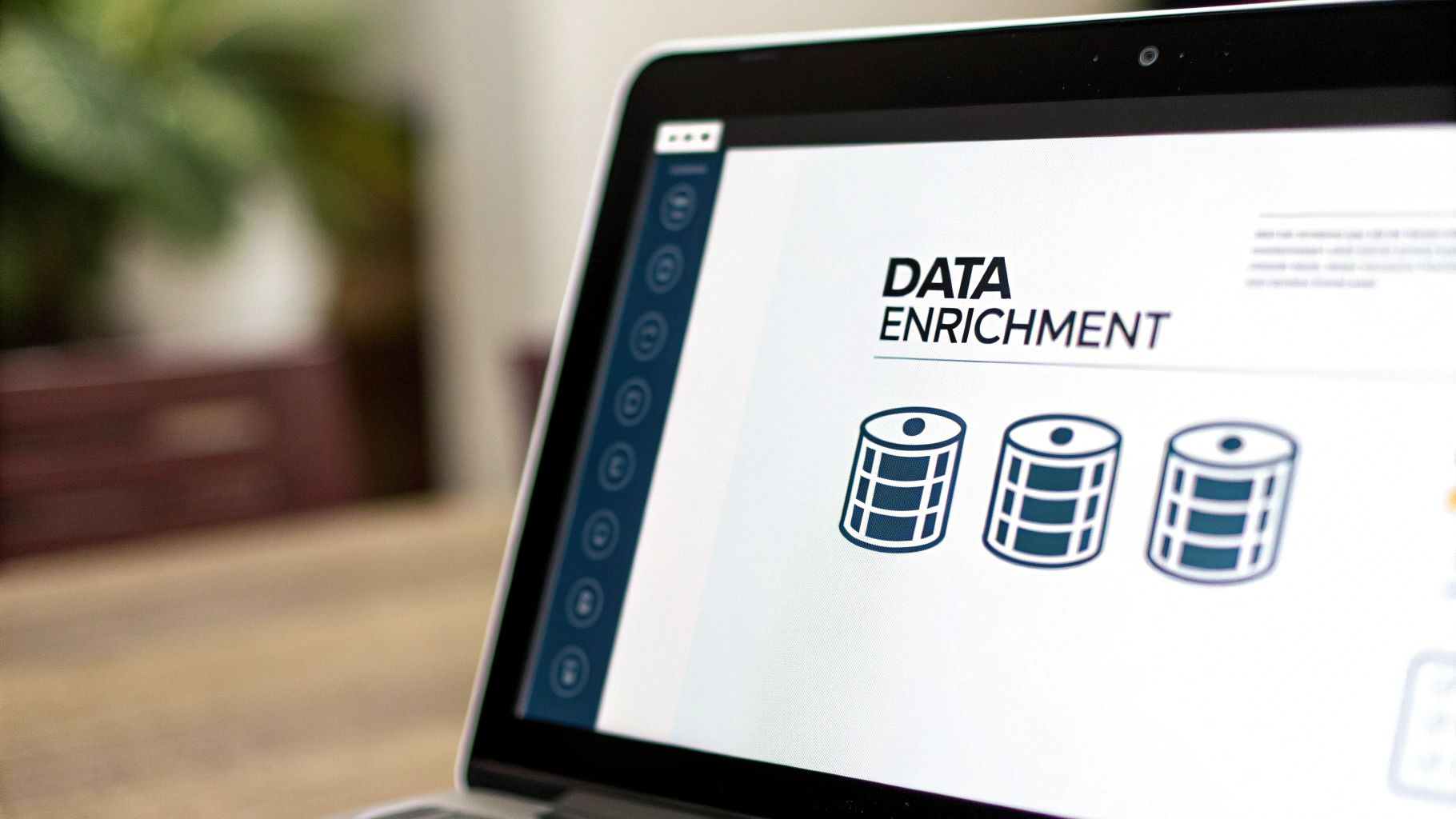
Picture your CRM as a basic world map. You can see the countries, but that's about it. You know roughly where your contacts are, but you have none of the details needed to navigate the terrain. Data enrichment transforms that simple map into a live GPS, showing you every city, road, and even the traffic. It turns a static address book into a dynamic, strategic tool.
At its heart, data enrichment crm tackles a sneaky but expensive problem: your customer data is constantly going out of date. Contact information degrades at an astonishing rate—about 30% every year. People switch jobs, companies restructure, and phone numbers change. If you don't have a way to keep this information current, your sales and marketing teams are flying blind.
Moving Beyond Basic Contact Lists
A CRM with stale, incomplete data forces your team to be reactive. They waste huge chunks of their day manually digging for information on LinkedIn, verifying contact details, and fixing old records. This isn't just a minor annoyance; this administrative grind can eat up over 20 hours per month for each sales rep, killing productivity and morale. The result? Bounced emails, calls to disconnected numbers, and awkward conversations with people who left the company months ago.
A well-enriched CRM shifts your sales team from data janitors to strategic advisors. Instead of cleaning up messy records, they can focus on building relationships and closing deals with the right people at the right time.
Making this shift from a simple database to an intelligent system is no longer optional in modern sales. If this is a new concept for you, getting a handle on the basics of customer relationship management is a perfect place to start. It helps you see just how critical high-quality data is for nearly every sales and marketing activity.
The Foundation for Strategic Sales
When your data is complete and accurate, you can do things that were previously impossible. It directly fuels smarter business decisions and a much more efficient sales cycle. Here’s a look at what opens up:
- Improved Lead Qualification: You can automatically add firmographic data like company size, industry, and annual revenue. This lets your team instantly spot the high-value leads that perfectly match your Ideal Customer Profile (ICP). No more guesswork.
- Powerful Personalization: Imagine having access to a prospect's exact job title, their key responsibilities, or even the tech stack their company uses. This allows for incredibly relevant outreach. Your team can ditch the generic templates and craft messages that speak directly to a prospect's real-world challenges.
- Enhanced Decision-Making: Good data leads to reliable reports and forecasts. When you can actually trust the numbers in your CRM, you can confidently make strategic calls on everything from sales territories and resource planning to market expansion.
Ultimately, putting a data enrichment crm strategy in place is about building a single, reliable source of truth. It guarantees everyone on your team has the comprehensive, current information they need to engage prospects effectively and drive real growth.
The Business Impact of Enriched CRM Data
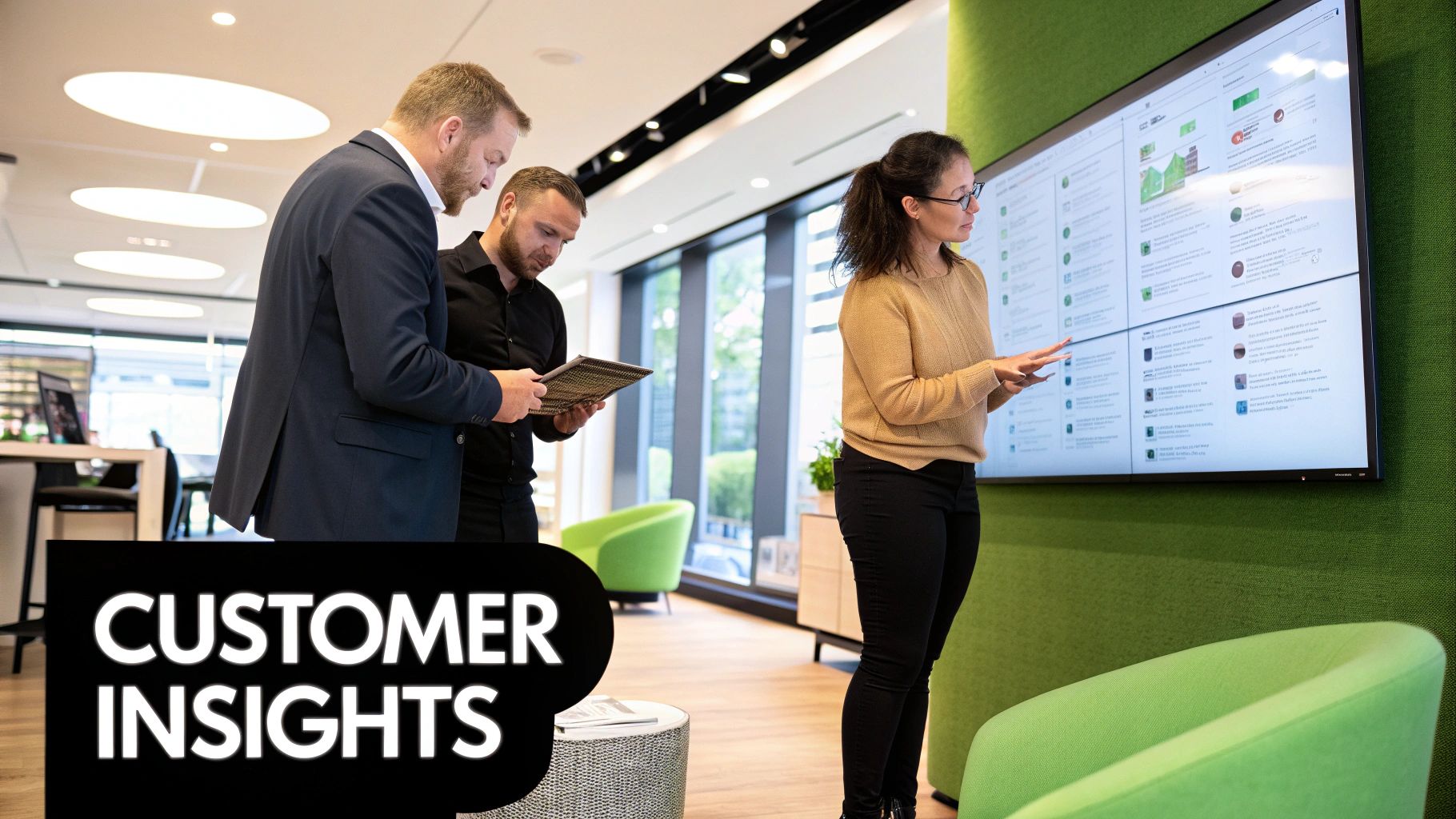
Putting a data enrichment CRM strategy into practice does a lot more than just tidy up your contact list. It’s a direct line to real revenue growth and a serious competitive edge. It’s about moving your sales team away from guesswork and gut feelings toward making smart, data-backed decisions that actually hit the bottom line. This is where you connect the dots between clean data and real cash flow.
When your sales team has a full, 360-degree picture of every single prospect and customer, their whole game changes. They stop wasting precious time chasing dead-end leads or sending out generic, one-size-fits-all emails. Instead, every call, email, and meeting is sharp, informed, and far more likely to get a "yes."
Achieve Hyper-Personalization at Scale
These days, personalization isn't a nice-to-have; it's what buyers expect. Enriched data is the raw material you need to build messages that feel like they were written for one person. By automatically adding details like company size, industry, and annual revenue to your records, your team can slice and dice your audience with surgical precision.
Think about a SaaS company that sells project management software. With a properly enriched CRM, they could instantly pull a list of every tech company in the Nordic region with 50-200 employees that just secured a new round of funding. That’s a game-changer. The sales team can now run a campaign that speaks directly to that growth, positioning their tool as the essential solution for teams that are scaling up. That’s how you turn a cold outreach into a genuinely helpful conversation.
Data enrichment allows you to stop selling to a generic market and start speaking directly to an individual's specific business context. This is the key to breaking through the noise and capturing attention.
This approach is quickly becoming the new baseline for success. By 2025, over 50% of companies are expected to be using AI-powered data enrichment in their CRM workflows. This isn't just a trend; it’s a response to incredible results. Marketers using these tactics have seen revenue jump by as much as 40%, and businesses that integrate these tools are 83% more likely to smash their sales targets. You can find more details on the rise of AI in data enrichment from Enricher.io.
Shorten Sales Cycles and Boost Retention
Is your sales cycle dragging on? It’s often a sign of a weak qualification process. When reps are chasing prospects who were never a good fit to begin with, they burn weeks on discovery calls and demos that lead nowhere. A data enrichment CRM process cuts through that by giving you the critical information needed to qualify—or disqualify—a lead right away.
This has a huge ripple effect across your entire sales pipeline. When your team can focus its energy on well-qualified leads, you'll see a few things happen almost immediately:
- Faster Lead Routing: The right leads get to the right reps automatically, based on territory, industry, or company size.
- More Efficient Demos: Reps can tailor their product demos to solve the prospect’s specific problems from the very first meeting.
- Reduced Time-to-Close: Conversations are focused and relevant from day one, which naturally speeds up the journey from prospect to paying customer.
The numbers don't lie. Moving from guesswork to a data-informed sales process has a clear and measurable impact on the metrics that matter most.
Impact of Data Enrichment on Key Sales Metrics
| Metric | Before Enrichment | After Enrichment | Potential Improvement |
|---|---|---|---|
| Lead Conversion Rate | Low, with many unqualified leads | High, focused on ideal customers | Up to 70% increase |
| Sales Cycle Length | 90+ days | 60 days or less | 33% shorter |
| Customer Acquisition Cost | High due to wasted effort | Lower, with efficient targeting | 25% reduction |
| Customer Retention Rate | Standard industry average | Above-average, proactive engagement | 15%+ improvement |
These improvements aren’t just marginal gains; they fundamentally change the economics of your sales operation.
The benefits don't stop once a deal is closed, either. Enriched data is just as important for keeping your customers happy and loyal. By tracking changes like a key contact getting a promotion or their company being acquired, your customer success team can get ahead of potential churn risks and spot new upsell opportunities. For example, if your champion at a client company moves to a new role, you can reach out to their replacement right away to ensure a smooth handover. This kind of proactive work is what builds strong relationships and drives up customer lifetime value.
Understanding the Key Types of Enrichment Data
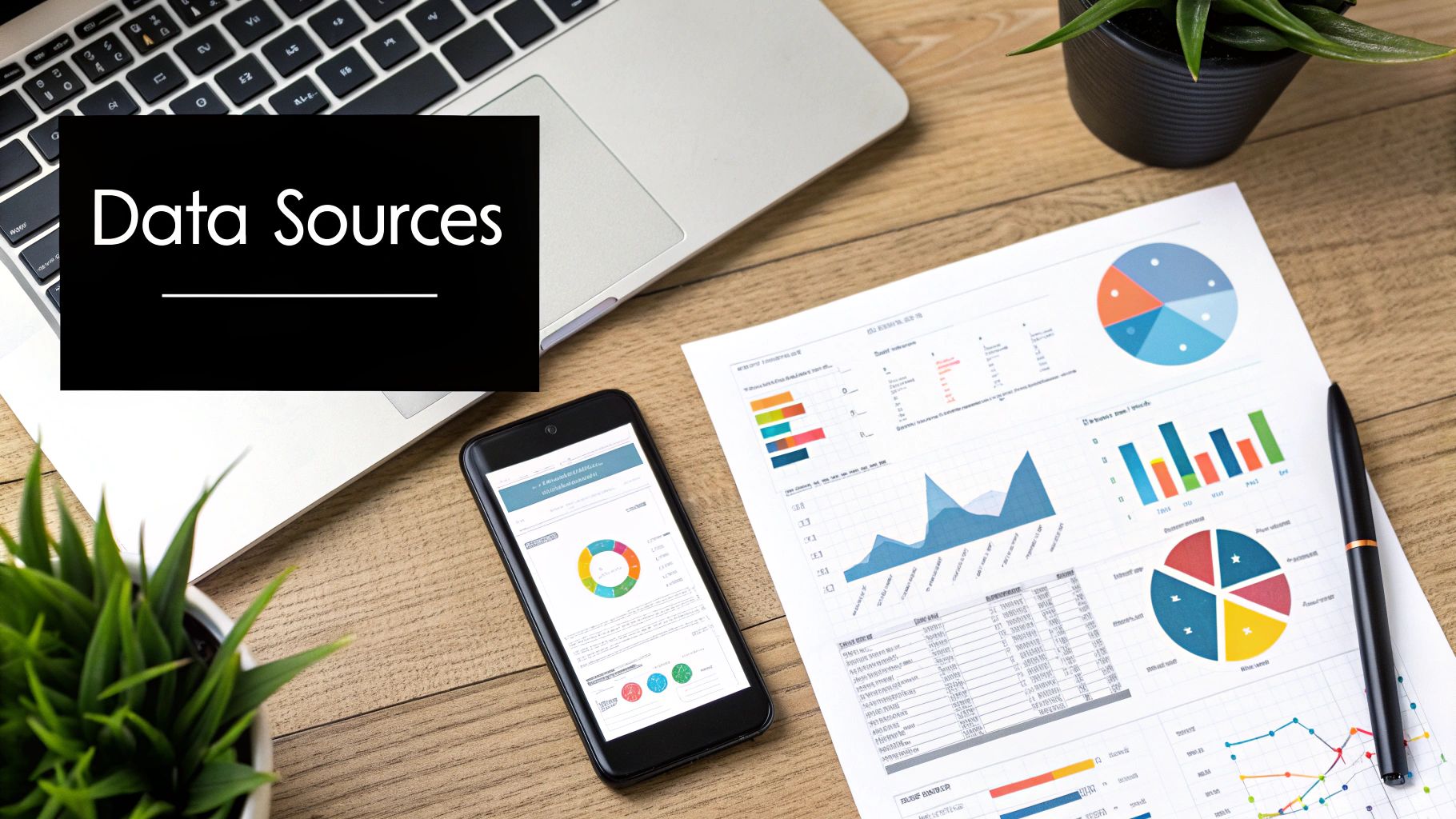
To really get your CRM working for you, turning it from a glorified address book into a sales powerhouse, you have to feed it the right information. A smart data enrichment crm strategy isn't about hoarding every scrap of data you can find. It's about strategically adding the key details that build a complete, actionable picture of your customer.
Think of it like building a detailed portrait of a prospect. You start with the basic outline—a name and an email address. Enrichment is the process of adding layers of color, texture, and detail. You keep adding until you can see not just the person, but their entire professional world, in sharp focus.
These layers of detail fall into four main categories: demographic, firmographic, technographic, and intent data. Each provides a different piece of the puzzle, and when you put them all together, your sales team gains a massive advantage. Let's break down what each type really means.
Demographic Data: Who Your Contacts Are
This is the most fundamental layer, focusing on the individual you're trying to reach. Demographic data helps you understand the person on the other end of the line on a human level. While your CRM might just have a name, enrichment fills in the professional context that actually matters.
This data typically includes details like:
- Job Title: Are they a manager, a director, or a C-level executive? This immediately tells you about their seniority and decision-making authority.
- Job Function: Do they work in IT, marketing, finance, or operations? This clues you into their daily priorities and professional pain points.
- Location: Knowing their city and country is crucial for managing sales territories and tailoring your outreach, especially when you’re targeting specific regions like the Nordics.
- Contact Information: This means getting a verified direct-dial number and a professional email, which is absolutely critical for cutting down on bounced emails and wasted calls.
Arming your team with this info ensures they’re not just talking to the right person, but that they have the context to start a relevant conversation from the first "hello."
Firmographic Data: Where Your Contacts Work
While demographics tell you about the person, firmographics tell you about the company they work for. For any B2B sales team, this is the bedrock of good targeting. It’s how you qualify an entire account and decide if it fits your Ideal Customer Profile (ICP).
Firmographic data helps you answer the most important question in B2B sales: "Is this the right type of company for us to be talking to?" It moves your team from a shotgun approach to a laser-focused strategy.
Common firmographic data points include:
- Industry: Are they in SaaS, manufacturing, finance, or another vertical you specialize in?
- Company Size: How many employees do they have? This often hints at their budget, complexity, and needs.
- Annual Revenue: Understanding a company's financial health helps you gauge its real purchasing power.
- Geographic Location: Pinpointing headquarters and office locations is vital for building regional sales strategies.
For a SaaS company selling to Nordic decision-makers, discovering a prospect is a 150-person tech firm in Stockholm with $20 million in revenue is pure gold. That one sentence allows for instant qualification and a highly specific pitch.
Technographic Data: What Tools They Use
This is where things get really interesting. Technographic data gives you a peek inside a company's technology stack. For a SaaS sales team, this is an incredibly powerful dataset because it reveals technical needs, potential integration hooks, and golden opportunities to unseat a competitor.
Think of it as getting a look inside their digital toolbox before you even start the conversation.
For instance, a data enrichment crm process might show that a target company uses a competitor's marketing software, a specific cloud provider like AWS, or an analytics tool you know is outdated. This information gives you an immediate and compelling reason to get in touch.
A sales rep can then open with, "I see you're using Competitor X. Our platform actually integrates with it to solve [specific problem], and we offer a few key features they don't." That’s a world away from a generic, easily-ignored cold email.
Intent Data: What They Want to Buy
If the other data types tell you who to talk to, intent data tells you when. This is arguably the most powerful type of enrichment for perfect timing. It tracks a company's online behavior to find signals that they are actively researching solutions just like yours. In short, it shows you who is in "buying mode" right now.
These buying signals can include:
- High-Volume Topic Research: Multiple employees from the same company suddenly start reading articles about "B2B lead generation." That's a huge flag.
- Competitor Website Visits: You see that they're spending time on your competitors' pricing or product pages.
- Product Review Consumption: They’re actively checking out reviews on sites like G2 or Capterra.
By feeding this data into your CRM, you can prioritize outreach to companies that are already in the market. It allows your sales team to stop guessing who to call and instead focus on prospects who have all but raised their hand, turning cold calls into warm, timely conversations.
How to Implement Your Data Enrichment Strategy
A powerful data enrichment CRM strategy doesn't just happen. It takes a clear, methodical approach to turn your current database into a high-performance sales engine. By following a structured plan, you can sidestep common mistakes and make sure your investment delivers real results right from the start.
Think of it like building a sturdy foundation before putting up a skyscraper. You wouldn't pour concrete without surveying the land first, right? In the same way, you shouldn't start throwing data at your CRM without a clear picture of where you are and where you're trying to go.
This simple workflow shows how raw, basic information is systematically enhanced before it becomes a trustworthy asset inside your CRM.
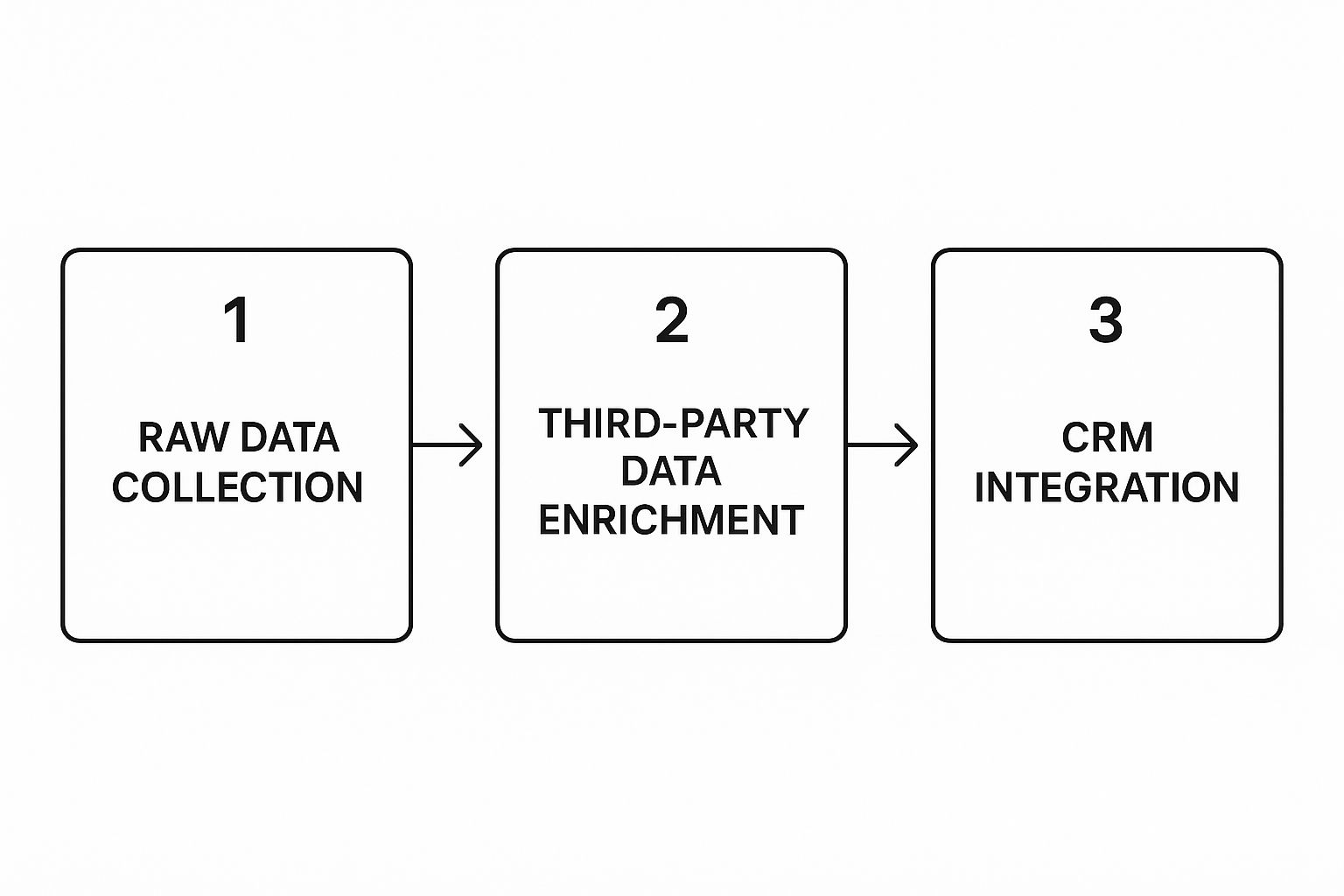
Let's walk through the essential stages to get this done right.
Stage 1: Audit Your Current CRM Data Health
Before you can improve your data, you have to know exactly what’s wrong with it. A thorough data audit is your diagnostic phase. It’s all about taking an honest look at the state of your CRM to find the most critical gaps and inconsistencies.
Start by digging into the key fields that actually impact your sales and marketing efforts. Track metrics like:
- Completion Rate: What percentage of your contact records are missing a job title, direct phone number, or company size?
- Accuracy Rate: How many of your emails are bouncing? How many phone numbers are just dead ends?
- Duplication Rate: How many duplicate contacts or company records are cluttering up your system?
This initial audit gives you a crucial benchmark. It helps you decide which data points to tackle first and gives you a baseline to measure your success against later on.
Stage 2: Define Your Ideal Customer Profile
Once you have a clear picture of your data's health, the next step is to define precisely who you're selling to. An Ideal Customer Profile (ICP) is basically a detailed description of the perfect company you want as a customer. Without this, your enrichment efforts will be scattered and ineffective.
Your ICP should be built on solid firmographic and technographic data. For a SaaS company targeting decision-makers in the Nordics, this might look something like:
- Industry: Software & IT Services
- Location: Sweden, Denmark, Norway, Finland
- Company Size: 50-500 employees
- Technology Used: Currently using a competitor's software
Your ICP is the North Star for your entire data enrichment strategy. It tells your enrichment tools precisely what information is valuable, ensuring you only pay for and collect data that directly supports your sales goals.
Stage 3: Choose the Right Enrichment Tools
Now it’s time to pick your tools. The market for data enrichment CRM solutions is booming, with the industry projected to jump from $7.55 billion in 2025 to $16.72 billion by 2034. This growth is great news—it means you have plenty of options, but you need to choose carefully. You can learn more about the growing data enrichment solution market from Market Research Future.
When you're evaluating vendors, be sure to ask some tough questions:
- Data Accuracy and Source: Where do they get their data, and how often is it verified? Ask them straight up about their accuracy guarantees.
- CRM Integration: Is it a seamless, native integration with your CRM, or is it going to require a complicated custom build?
- Real-Time vs. Batch: Can it enrich data the moment a new lead comes in, or does it only do scheduled batch updates?
- Regional Coverage: How good is their data in your target markets, like the Nordics? This is a deal-breaker.
Picking a tool that fits your tech stack and your strategic goals is absolutely essential for a smooth rollout.
Stage 4: Integrate and Automate the Process
After you've selected your tool, the goal is to make enrichment an automated, invisible part of your team's daily workflow. This means setting up the integration with your CRM and defining rules for how and when data gets updated.
For example, you can build a workflow where every new lead that hits your CRM is automatically sent to the enrichment tool. The tool then fills in the missing pieces—like company size, industry, and job title—and syncs it back to the CRM record in seconds. This ensures your sales team always has a complete profile before they even pick up the phone.
Stage 5: Establish a Data Governance Plan
Finally, remember that data enrichment isn't a one-time project; it’s an ongoing discipline. A data governance plan is just a set of rules and processes to keep your data high-quality over the long haul. This is how you protect your investment and ensure your CRM remains a reliable source of truth.
Your plan should clearly outline:
- Data Ownership: Who in your organization is ultimately responsible for data quality?
- Refresh Schedule: How often will you re-enrich your database to fight data decay? (A quarterly refresh is a common best practice).
- Data Standards: What are the formatting rules for data entry? (e.g., standardizing country names or job titles to keep things consistent).
This final step turns data enrichment from a project into a core business process. It guarantees your team can trust the information in your CRM for years to come.
Choosing the Right Data Enrichment Tool
With so many data enrichment tools on the market, picking the right one can feel like a chore. But it doesn't have to be. The best way to start is by understanding the three main types of solutions out there: native CRM add-ons, third-party integrations, and standalone platforms.
Each has its place, and the best choice for you really depends on what your team needs. A native add-on is often the easiest to get running since it lives right inside your CRM. Third-party tools can offer more specialized data but might take a bit more work to connect. Standalone platforms are the powerhouses, acting as a central source of truth for your entire tech stack, though they often need more technical know-how to manage.
Key Evaluation Criteria
Before you even start looking at demos, you need a checklist. Knowing what to look for will help you cut through the marketing noise and focus on what actually matters for your business.
Think about these key points when you're comparing your options:
- CRM Compatibility: How well does it actually play with your CRM? Is it a true, native integration, or will your tech team need to build a custom connection that could break? This is non-negotiable.
- Data Accuracy: This is the big one. Ask vendors tough questions. Where do they get their data? What's their guaranteed accuracy rate? Don't accept vague answers.
- Real-Time vs. Batch Processing: Does your team need lead data updated the second it hits the CRM? That's real-time enrichment. Or is an overnight or weekly update (known as batch processing) good enough? Real-time is fantastic for fast-moving sales teams but usually costs more.
- Compliance Certifications: If you're selling into Europe, this is critical. Make sure any tool you’re considering is fully GDPR compliant. No exceptions.
The right tool fits your budget, plugs into your current workflow without a fuss, and delivers trustworthy data for the specific market you're targeting. Making a smart choice now saves you from the headaches of bad data or being stuck with the wrong vendor later on.
The demand for better customer data is exploding. The global CRM market is on track to blow past $112 billion in 2025 and is projected to hit nearly $262 billion by 2032. You can read more about these CRM market insights and statistics from Kixie. This growth is all about companies needing to get smarter with their data.
Comparison of Data Enrichment Tool Types
To help visualize the differences, here’s a quick breakdown of the main tool types and where they shine. This should help you narrow down which category makes the most sense for your team's needs and resources.
| Tool Type | Best For | Key Advantage | Potential Drawback |
|---|---|---|---|
| Native CRM Add-Ons | Teams looking for a quick, simple solution within their existing CRM (e.g., Salesforce AppExchange). | Simplicity. Fast to install and easy to manage directly inside the CRM interface. | Often has limited data sources or less customization compared to other options. |
| Third-Party Integrations | Companies needing specialized or niche data (e.g., industry-specific firmographics) that a native tool might not offer. | Flexibility. Connects best-in-class data providers to your CRM via APIs for more tailored results. | Can require more technical setup and maintenance to keep the integration running smoothly. |
| Standalone Platforms | Larger organizations with multiple teams and systems needing a centralized, authoritative data source. | Power & Scale. Acts as a central data hub that can clean, enrich, and distribute data across the entire company. | Higher cost and complexity; often requires a dedicated team or technical expertise to manage effectively. |
Ultimately, choosing the right solution comes down to your specific goals. Taking a deeper look into B2B data enrichment strategies will give you a clearer picture of which approach fits your company's workflow. The perfect tool is one that gives your team accurate, useful information without making their jobs more complicated.
Keeping Your CRM Data Sharp Over Time
Getting your data enrichment CRM process up and running is a huge win, but it's just the start. Think of your CRM like a high-performance car. You can't just drive it off the lot and expect it to run perfectly forever. It needs regular tune-ups and oil changes. Your data is no different; it needs constant attention to stay valuable.
This isn't a one-and-done project. It's an ongoing discipline. The hard truth is that contact information goes stale incredibly fast. People switch jobs, companies get bought, and phone numbers change. In fact, business contact data decays at a staggering rate of about 30% every year. Without a solid maintenance plan, that beautifully clean CRM you just built will quickly become a mess of outdated, unreliable information.
Establish Clear Data Ownership
Let's get one thing straight: when everyone is responsible for data quality, no one is. It’s the classic "tragedy of the commons." To really tackle data decay, you need to assign clear ownership. Pick a person or a team—usually someone in RevOps or SalesOps—and make them the official guardian of your CRM data.
This doesn't mean they're stuck doing manual data entry all day. Their job is much more strategic. This data steward is in charge of:
- Setting Data Standards: They create the rulebook for how data is entered and formatted, ensuring consistency across the board.
- Monitoring Data Health: They keep an eye on key quality metrics, spotting trouble before it snowballs into a bigger problem.
- Managing Enrichment Tools: They own the tech stack and processes that automate the cleaning and updating of your data.
By putting someone in charge, you transform data quality from a vague idea into a core, accountable part of your business.
Put a Cleansing and Verification Schedule in Place
You have to be proactive. Waiting for your sales reps to complain about bad leads means you're already losing deals. A regular, scheduled cleansing and verification routine is the only way to protect your data enrichment crm investment long-term.
Data quality is not a destination; it's a continuous process. Regular, scheduled maintenance ensures your CRM remains the single source of truth that your entire organization can rely on.
Your maintenance schedule should lock in two critical activities:
- Quarterly Data Re-Enrichment: At least once a quarter, run your entire contact database through your enrichment tool. This will catch all the recent changes—new job titles, updated phone numbers, company mergers, you name it.
- Continuous Verification: Don't rely on a single source of truth. The best tools cross-reference information from multiple sources to confirm its accuracy. If you're seeing a lot of conflicting information, taking a moment to understand the most common data quality problems can help you build a smarter verification strategy.
Stay on the Right Side of Privacy Regulations
With privacy laws getting stricter every year, compliance isn't optional. This is especially true if you’re selling to decision-makers in the Nordics, where GDPR rules are rigorously enforced. Great data isn't just accurate—it's also handled responsibly.
This screenshot from the official GDPR portal shows the core principles of data processing. These are the rules of the road for compliant data management.
Principles like accuracy, data minimization, and storage limitation aren't just legal jargon; they're directly supported by a solid data maintenance routine.
Any good, modern enrichment tool should come with features designed to help you stay compliant, like consent management flags that track and honor user preferences. Always double-check that your processes and your vendors align with legal requirements. It protects your customers, shields your business from massive risk, and is fundamental to building trust.
Common Questions on CRM Data Enrichment
Even with the best plan in place, a few practical questions always pop up when you start enriching your CRM data. Let's tackle some of the most common ones so you can move forward with confidence.
How Often Should We Enrich Our Data?
Think of your CRM data like fresh produce – it has a shelf life. Business contact information degrades surprisingly fast, by about 30% every year, so a one-and-done update just won't work.
For new leads coming in, a real-time, continuous enrichment process is the gold standard. For your existing database, you should plan to do a full refresh at least quarterly. This regular tune-up ensures your team is always working with the most reliable information.
What’s the Difference Between Data Cleansing and Enrichment?
People often use these terms interchangeably, but they're two sides of the same data quality coin. Knowing the difference is crucial for a solid data strategy.
- Data Cleansing: This is all about housekeeping. It’s the process of finding and fixing or removing incorrect, outdated, or duplicate information that’s already in your CRM. You're tidying up what you have.
- Data Enrichment: This is about adding value. You’re taking your existing records and appending new, valuable information to them from an outside source, making them much more complete.
In a nutshell: cleansing fixes the data you have, while enrichment adds the data you're missing. You really need both for a healthy CRM.
How Does This Work with Privacy Laws like GDPR?
This is a big one, and it's non-negotiable, especially if you're targeting the Nordics. Any reputable data enrichment provider will have built their entire service with regulations like GDPR at its core. They have to ensure the data they supply is gathered and handled legally.
When you're vetting a tool, make this a priority. Check for transparent data sourcing and clear processes for managing user consent. Running a compliant data enrichment CRM process isn't just about avoiding risk; it's about building trust with the very people you want to do business with.
Ready to turn your incomplete CRM into a powerhouse for your sales team? The Nordic Lead Database gives you the accurate, compliant firmographic and contact data you need to connect with key decision-makers across the Nordics. Find out more at https://nordicleaddatabase.com.
